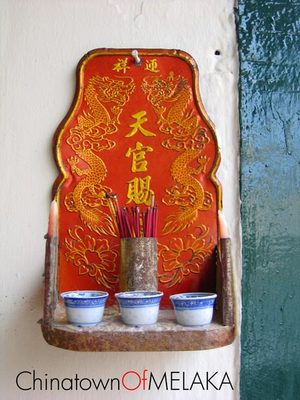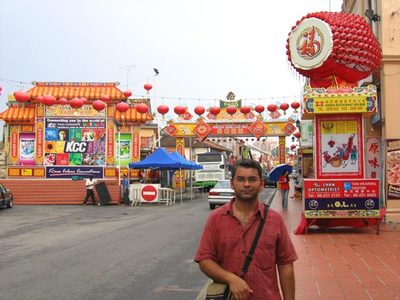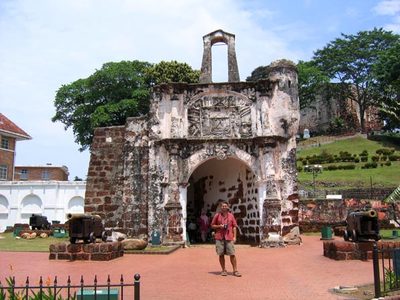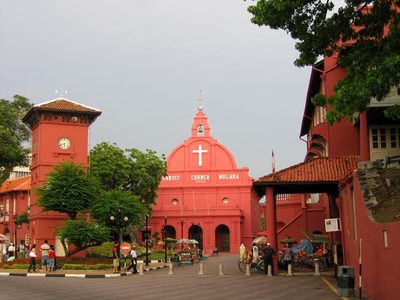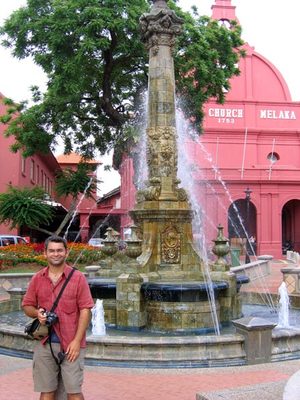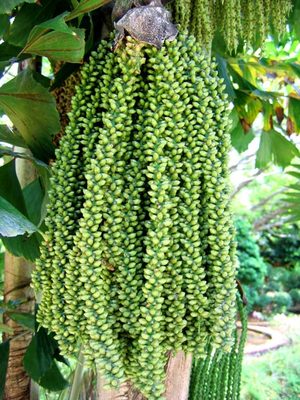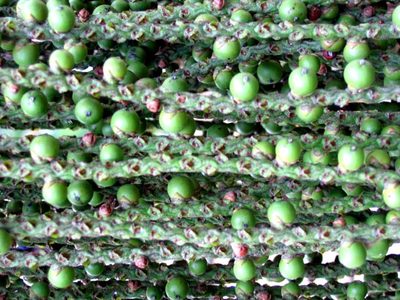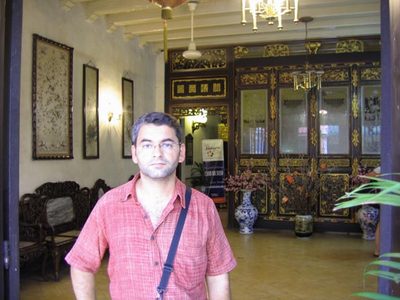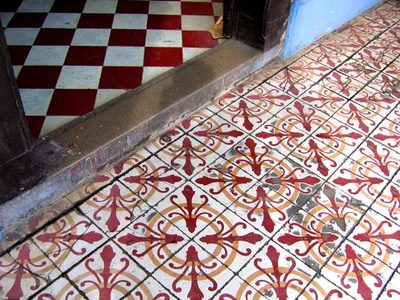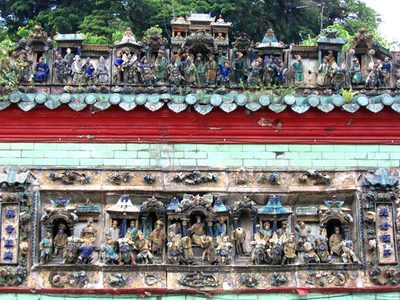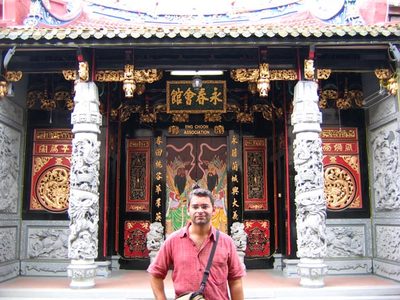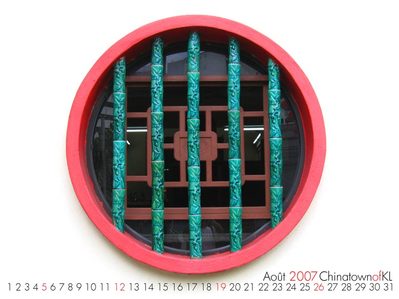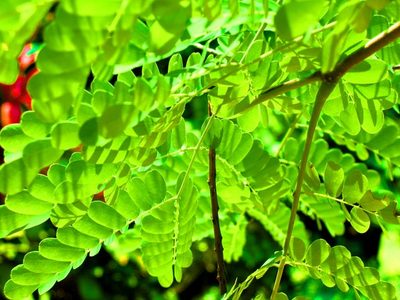Malaka, connue aussi sous le nom de Malacca, (Jawi : ملاك) est une ville de Malaisie, situé dans l'État de Malaka, dans le sud de la péninsule malaise.
La première mention écrite connue de Malaka provient d'un texte chinois, le Ko Kwo Yi Yu, qui relate une mission chinoise à Malaka en 1403. On doit à ce texte une liste de mots malais transcrits en caractères chinois, avec leur traduction en chinois.
Selon la tradition, Malaka a été fondée peu avant 1400 par Parameswara, un prince de la cité hindou-bouddhique de Palembang (sud de Sumatra) qui refusait la suzeraineté du royaume javanais de Majapahit et quitta Palembang. Malaka revendiqua la suzeraineté sur Palembang, mais la Chine prit le parti de Majapahit.
Située sur une grande voie de commerce international entre d'une part, de la Chine et des Moluques et d'autre part, l'Inde et le Moyen-Orient, Malaka devint rapidement le port le plus important de la région.
Les marchands musulmans jouaient un rôle prépondérant dans ce commerce. Parameswara se convertit à l’islam à la fin de son règne en 1414 et prend le nom d'Iskandar Shah.
L'expansionnisme du royaume thai d'Ayutthaya (1350-1767) (http://sefirots.joueb.com/news/24.shtml) est une menace pour Malaka. En 1405, la cité cherche la protection de la Chine et y envoie plusieurs missions, auxquelles participent les trois premiers souverains eux-mêmes. En retour, l'amiral chinois musulman Zheng He vient plusieurs fois à Malaka de 1405 à 1433, à la tête d'une énorme flotte. Le quartier de Bukit Cina témoigne de l'établissement de Chinois, qui considéraient qu'il avait le meilleur Feng Shui de la cité. Le cimetière chinois de Malaka est le plus grand cimetière chinois du monde hors de Chine.
Malaka est prise en 1511 par le vice-roi portugais des Indes, Afonso de Albuquerque, parti de Goa à la tête d'une flotte de dix-huit bateaux et 1 200 hommes. Le sultan Mahmud déplace sa cour à Johor dans le sud de la péninsule malaise. Les principautés portuaires de Java, alliées de Malaka, tentent plusieurs fois, sans succès, de reprendre la ville aux Portugais, notamment Jepara, en 1512-13 d'abord, puis de 1551 à 1574.
La prospérité de Malacca reposait sur un réseau commercial musulman dans lequel les Portugais n'arrivent pas à s'intégrer. Tomé Pires, un apothicaire portugais qui vécut à Malaka de 1512 à 1515, a pu décrire la richesse de Malacca et le dynamisme de son commerce. Avec les Portugais, le commerce de Malaka périclite rapidement. La cité est prise dans le conflit qui opposait le royaume d'Aceh dans le nord de Sumatra et le sultanat de Johor pour le contrôle du détroit. Aceh notamment lancera plusieurs attaques sur Malacca, sans succès. La première a lieu en 1537. C'est surtout le sultan Iskandar Muda (règne 1607-36) qui, dans le cadre des ses campagnes pour conquérir les principautés des deux côtés du détroit qu'il cherche à contrôler, défait notamment une flotte portugaise à Bintan dans l'archipel de Riau en 1614. Mais en 1639, Iskandar Muda lance une flotte sur Malacca, qui est totalement détruite avec 19 000 hommes perdus.
Immédiatement après la prise de Malaka, les Portugais lancent des expéditions dans les Moluques, où ils échouent à imposer aux royaumes locaux leur monopole sur la production et le commerce des épices. François Xavier, co-fondateur de Compagnie de Jésus avec Ignace de Loyola, passe plusieurs mois à Malaka en 1545, 1546 et 1549. De là, il jette les bases d'une mission aux Moluques. Il fut enterré à Malaka pendant quelques mois, avant que sa dépouille ne soit transférée à Goa.
En 1641, les Hollandais de la VOC (Vereenigde Oostindische Compagnie ou "Compagnie hollandaise des Indes orientales"), alliés à Johor, prennent à leur tour Malaka aux Portugais.
La prise de Malaka par les Portugais aura eu deux conséquences fondamentales : la rupture du réseau des marchands de l'Asie du Sud-Est insulaire et péninsulaire, et la christianisation de l'est de l'archipel indonésien.
Pour la VOC aussi, l'importance de Malaka résidait dans sa position sur le détroit. Les Hollandais signent en outre des accords commerciaux avec plusieurs États de la péninsule pour s'approvisionner en étain. Mais les Hollandais devaient aussi porter leurs efforts sur la lutte contre le royaume de Gowa dans le sud de Célèbes, dont l'expansionisme contrariait leurs propres visées aux Moluques. Avec la défaite finale de Gowa en 1669, la VOC concentre ses activités commerciales sur les Moluques et Java.
Dans les années 1670, la VOC ouvre un comptoir sur la côte est de Sumatra, d'où provient l'étain dont ils contôlent le commerce avec Malaka. Les droits perçus sur ce commerce forment une part importante des revenus de la ville. Mais le commerce de Malaka entre en déclin.
En 1795, le stadhouder (gouverneur militaire) de Hollande, Guillaume V d'Orange-Nassau, se réfugie en Angleterre devant l'invasion des armées françaises. D'Angleterre, il envoie une série d'instructions à ses administrateurs pour qu'ils cèdent les territoires néerlandais, dont Malacca, à l'Angleterre pour qu'ils ne tombent pas aux mains des Français.
Finalement, Malaka est cédée aux Britanniques par le Traité de Londres de 1824, qui scelle la séparation entre la péninsule et Sumatra et la coupure du monde malais en deux.
De 1826 à 1946, Malaka fut gouvernée par la Compagnie anglaise des Indes orientales et ensuite comme une Colonie de la Couronne. Elle fut incluse aux comptoirs des détroits avec Singapour et Penang. Après la dissolution des colonies de la Couronne, Malaka et Penang participèrent à l'Union malaise, qui prendra ensuite le nom de Malaisie.
Les Malais (50%) et les Chinois (40%) constituent les deux groupes ethniques principaux, les Indiens formant un groupe ethnique minoritaire. Il existe toujours une minorité Eurasienne descendante des métis portugais de Malaka. Ils parlent toujours un ancien portugais créole appelé Cristao, aussi appelé Papia Kristang.
Un grand nombre de traditions d’origines portugaises sont toujours pratiquées de nos jours. Il en est ainsi de l’"Intrudu", du "branyu" (danse traditionnelle), et de "santa cruz" (fête annuelle dans la rue).
Malaka est aussi une place forte pour les Chinois, appelés Peranakan, dont l’installation dans la cité remonte à commerce Indo-Chinois. Il existe toujours plusieurs temples et bâtiments chinois à Malaka et dans ses environs.
Une légende veut que Zheng He ait emmené à Malaka une ravissante princesse chinoise, Hang Li Poh (汉丽宝), Elle s’était convertie à l’Islam et allait épouser le sultan Mansur Shah.
Pour éviter que la princesse ne souffre du mal du pays, l’Empereur avait ordonné qu’elle soit accompagnée par cinq cents suivantes et leurs servantes. La légende populaire veut que ces jeunes filles se soient par la suite mariées et établies à Malaka dans une région appelée Bukit Cina ou Colline des Chinois. Il n’est pas certain que cette histoire soit basée sur des faits historiques. Il semble plus probable que les Chinois qui se sont établis à Malaka aient été des commerçants ou des marins. Une chose est sûre : Zheng He a fait régulièrement escale à Malaka au cours de ses nombreux voyages depuis la Chine.
Les Indiens, groupe minoritaire, sont appelés Chitty.
Peranakan, Baba-Nyonya (峇峇娘惹) and Straits Chinese (土生華人; named after the Straits Settlements) are terms used for the descendants of the very early Chinese immigrants to the Nusantara region, including both the British Straits Settlements of Malaya and the Dutch-controlled island of Java among other places, who have partially adopted Malay customs in an effort (chronological adaptation) to be assimilated into the local communities.
The word Peranakan is also used to describe Chinese Indonesians. In both Malay and Indonesian, 'Peranakan' means 'descendants'. Babas refer to the male descendants and the Nyonyas the female. The word nyonya (also commonly spelled nonya) may originate from the Portuguese word dona, which means 'lady'.
Most Peranakan are of Hokkien ancestry, although a fair denomination of them are of the Teochew or Cantonese descent. Written records from the 19th and early 20th centuries show that Peranakan men usually took brides from within the local Peranakan community. Peranakan families also commonly imported brides from China and sent their daughters to China to find husbands. A small group of Indian Peranakans, known as the Chitty, does exist as well. Another similar group of Eurasian Peranakans also exist as Kristang people.
The language of the Peranakans, Baba Malay (Bahasa Melayu Baba) , is a dialect of the Malay language (Bahasa Melayu), which contains many Hokkien words. It is a dying language and contemporary use is mainly limited to members of the older generation; this is indicative also of the Peranakan culture at large. However most Peranakans do speak English, Mandarin and their respective Chinese dialects in addition to Baba Malay.
In the 15th century, the city states of the Malay Peninsula often paid tribute to various kingdoms such as the kingdoms of China and Siam. Close relations with China were established in the early 15th century, during the reign of Parameswara, when Admiral Zheng He (Cheng Ho), a Muslim Chinese, visited Malacca. In return for such tribute, a princess of China, Hang Li Po was presented as a gift to Sultan Mansur Shah, the Sultan of Malacca, at that time (+/-1459 AD). The royalty and servants who accompanied the princess initially settled in Bukit Cina and eventually grew into a class of straits-born Chinese known as the Peranakan. The Peranakan retained most of their ethnic and religious origins (ancestor worship), but assimilated the language and culture of the Malays. They developed a unique culture and distinct foods. A lot of sources claim that the early Peranakan inter-married with the local Malay population. However, the lack of physical resemblances have also led many experts to believe that the Peranakan Chinese ethnicity has hardly diluted. Some Peranakan distinguish between Peranakan-Baba (those Peranakan with part Malay ancestry) from Peranakan (those without any Malay ancestry). The Peranakan often sent their sons and daughters to China to look for spouses. Also, the religion of the local Malay population was Islam which forbids inter-marriage with other religions without conversion first. In the early 1800s, new Chinese immigrants to the Straits Settlements bolstered the Peranakan population.
Over the centuries, the Peranakans have evolved a unique culture that maintains many Chinese traditions, such as celebrating the Lunar New Year and the Lantern Festival, while adopting the customs of the land they settled in, as well as those of their successive colonial rulers. There are traces of Portuguese, Dutch, British, Malay and Indonesian influences in Baba culture.
Nonya cuisine combines Chinese, Malay and other influences into a unique blend. The old Malay word nonya (also spelled nyonya), a term of respect and affection for women of prominent social standing (part “madame” and part “auntie”), has come to refer to the cuisine of the Perakanans. Nonya cooking is the result of blending Chinese ingredients and wok cooking techniques with spices used by the Malay community. The food is tangy, aromatic, spicy and herbal. Key ingredients include coconut milk, galangal (a subtle, mustard-scented rhizome similar to ginger), candlenuts as both a flavoring and thickening agent, laksa leaf, pandan leaves (Pandanus amaryllifolius), belachan, tamarind juice, lemongrass, torch ginger bud, jicama, fragrant kaffir lime leaf, rice or egg noodles and cincaluk - a powerfully flavored, sour and salty shrimp-based condiment that is typically mixed with lime juice, chillies and shallots and eaten with rice, fried fish and other side dishes. The unique flavor of laksa (a spicy noodle soup) and other Nonya recipes is determined by the rempah, a combination of spices pounded into a paste with pestle and mortar, with a very specific texture and density. It is said that a nonya can determine the culinary skill of a new daughter-in-law simply by listening to her preparing rempah with a mortar. Nonya recipes are handed down from one generation to the next, and because of the time-consuming preparation of these dishes, it is a cuisine that is often at its best when served at home. Laksa is a notable exception to this rule. Examples of Nonya specialities include otak-otak, a popular blend of fish, coconut milk, chilli paste, galangal, and herbs wrapped in a banana leaf; Buah Keluak, a distinctive dish combining chicken pieces with Indonesian black nuts to produce a rich sauce; and Itek Tim, a classic soup containing duck, tomatoes, green peppers, salted vegetables, and preserved sour plums simmered gently together. Nonya desserts include colourful cakes and sweet, sticky delicacies.
By the middle of the twentieth century, most Peranakan were English educated, as a result of the British colonisation of Malaya, and the natural propensity of these people who were able to easily embrace new cultures. Because the Peranakans readily embraced English culture and education, administrative and civil service posts were often filled by prominent Straits Chinese. The interaction with the British also caused many in the community to convert to Christianity. The Peranakan community thereby became very influential in Malacca and Singapore and were known also as the King's Chinese due to their perceived loyalty to the British Crown. Because of the interaction of the different cultures and languages that Peranakans had, most Peranakans were (and still are) trilingual, being able to converse with Chinese, Malays and the British. Common vocations were as merchants, traders, and general intermediaries between China, Malaya and the West; the latter was especially valued by the British, since the Babas also enjoyed good relations with the Malay community and served as advisors to the royal Malay courts. In fact the term "Baba" is an honorific term in Malay; probably derived from Hindi/Sanskrit [Baba: literally means grandfather or father, and is used as a term of reverence and affection for an elderly gentleman].
Historical and cultural items from the Baba culture are displayed in cultural establishments on Heeren Street, Jonker Street and other streets in the same neighbourhood in Malacca and in Penang in Malaysia, and at the Peranakan Museum in Singapore. There one can find museums displaying furniture, food stuff, and even traditional clothes of the Baba and Nonya. There are also a small number of "Nyonya" restaurants in Singapore, Penang, Malacca, and the West. Free weekly street shows featuring Baba performances, and traditional and pop Chinese cultural performances are found in Jonker Street in Malacca (Melaka). The shows are part of the night market scene, and are usually crowded with shoppers, both local and foreign.
The Peranakans were partially assimilated into the Malay culture (especially in food, dress, and language), while retaining some Chinese traditions (religion, name, and ethnic identity), thereby creating a fusion culture of their own. For instance, from their Malay influence, a unique "Nyonya" cuisine has developed using the spices of Malay cuisine (examples are Chicken Kapitan, a dry chicken curry, and Inchi Kabin, a Nyonya version of fried chicken). The women (Nyonyas) have taken to wearing the baju kebaya (a Malay dress, seen most notably as the uniform of Malaysia and Singapore Airlines' female flight attendants). However, most of the Peranakans are not Muslim, and have retained the traditions of ancestor worship of the Chinese; though some converted to Christianity. The wedding ceremony of the Peranakan is largely based on Chinese tradition, and is one of the most colorful and fascinating wedding ceremonies in Malaysia and Singapore.
Peranakan culture is disappearing. Without colonial British support for their perceived racial neutrality, government policies in both countries following independence from the British have resulted in the assimilation of Peranakans back into mainstream Chinese culture. In Singapore, the Peranakans are classified as ethnically Chinese, so they receive formal instruction in Mandarin Chinese as a second language (in accordance with the "Mother Tongue Policy") instead of Malay. In Malaysia, the standardization of Malay as Bahasa Melayu — required for all ethnic groups — has led to a disappearance of the unique characteristics of Baba Malay.
The migration of some Peranakan families, particularly the well-to-do ones, has led to a small Peranakan disapora in neighbouring countries, from Vietnam to Australia. However, these communities are very small, and with the increasing use of the various languages in their respective countries, the use of Peranakan Malay or Baba Malay will be diluted.
Associations of Chinese Peranakan include the Peranakan Association of Singapore and the Gunung Sayang Association, a performing arts group. The Peranakan Association has about 1700 members, and the Gunung Sayang has about 200 members. Although the Peranakan Association consists of a mix of young and old, the Gunung Sayang Association has primarily elderly or retired members. In Malacca, there is an Indian Peranakan Association known as the Chitty Melaka. This is a tightly knit community of Saivite Hindus. Chitty Peranakans display considerable similarity to Chinese Peranakans in terms of dressing, songs and folk dances.
Le calendrier du mois d'aout 2007.
Commentaires :
Version XML - Cette page est peut-être encore valide XHTML1.1 et CSS sans tableaux.

